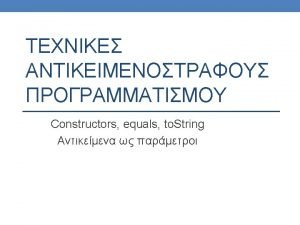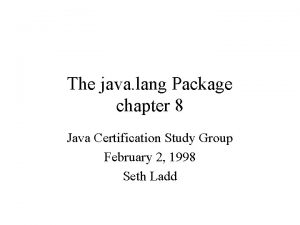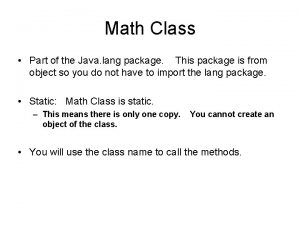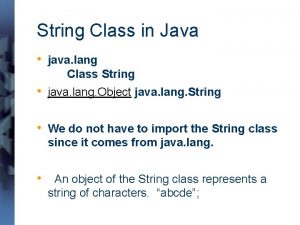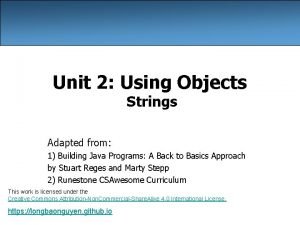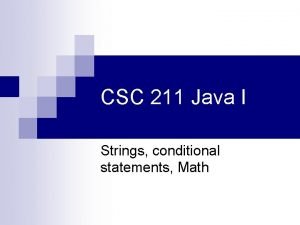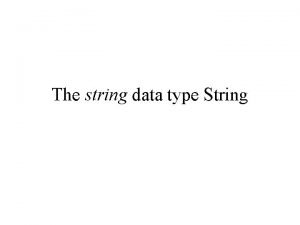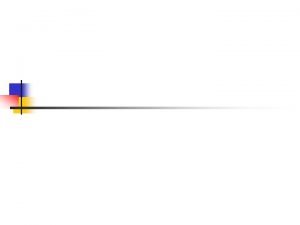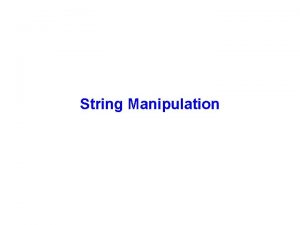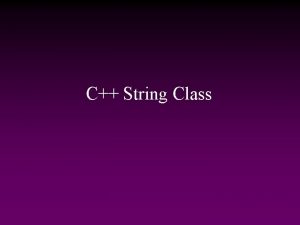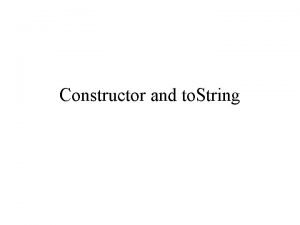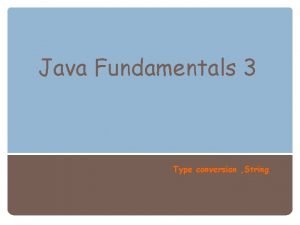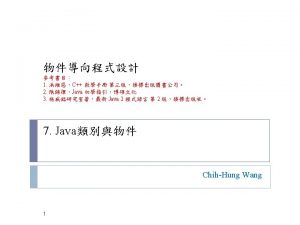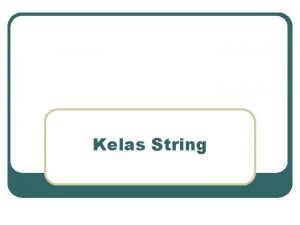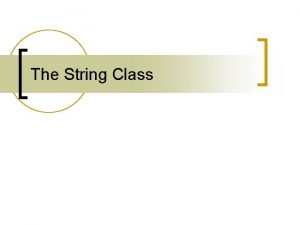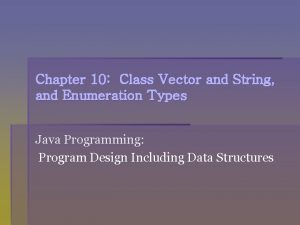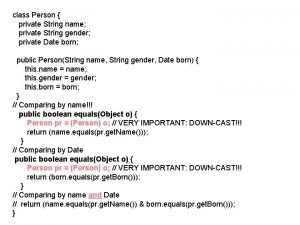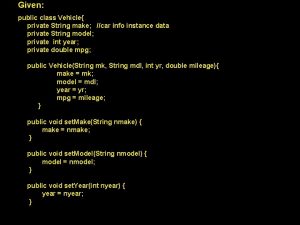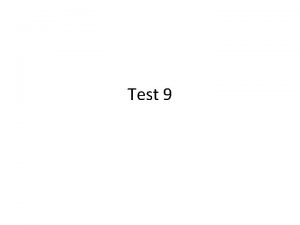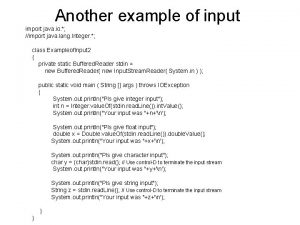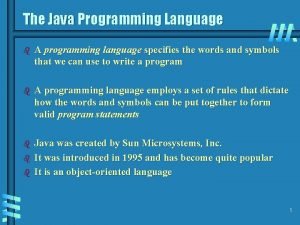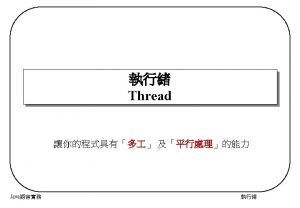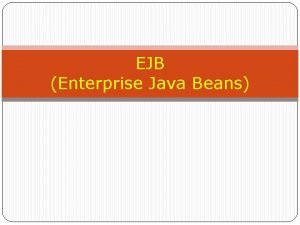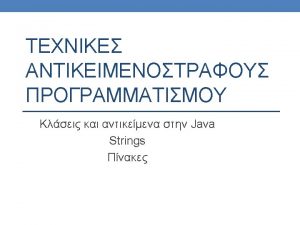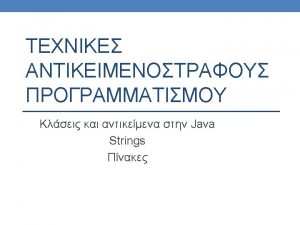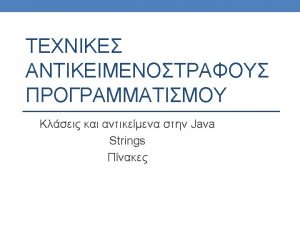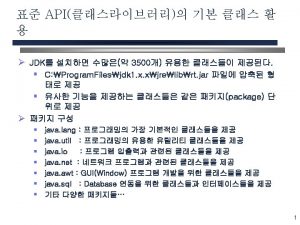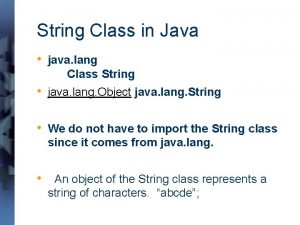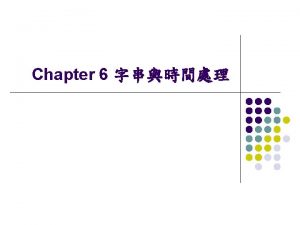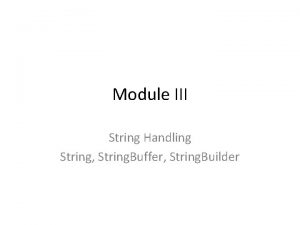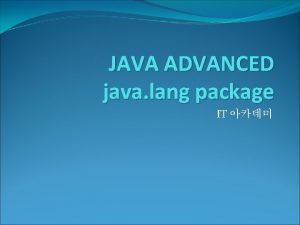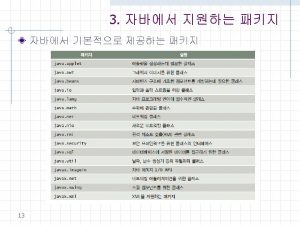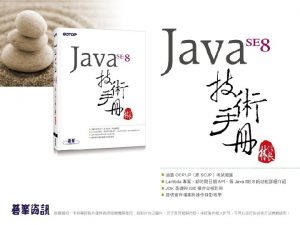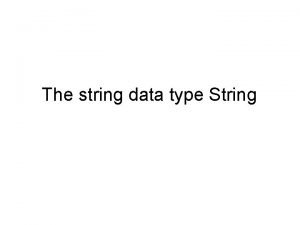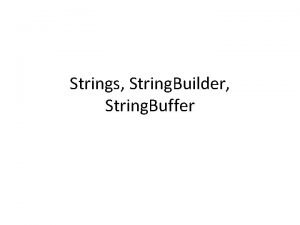java lang q java lang q q String








![包装类 6 -5 public class Test. Character { q public static void main(String[] args) 包装类 6 -5 public class Test. Character { q public static void main(String[] args)](https://slidetodoc.com/presentation_image/5f1aaf453a33a356e4d2b7d7c5fcb477/image-9.jpg)

































- Slides: 42

java. lang包

目标 q 了解 java. lang 包 q 掌握包装类 q 掌握String 和 String. Buffer 类 q 运用以下类的方法: q. Math q. Class q. Object 2


包装类 6 -2 4 原始数据类型 包装类 byte(字节) Byte char(字符) Character int(整型) Integer long(长整型) Long float(浮点型) Float double(双精度) Double boolean(布尔) Boolean short(短整型) Short



包装类 6 -3 public class Number. Wrap { /** 构造方法 */ q protected Number. Wrap() { 包装类的用法 q }使用包装类的方法,如 ceil()、floor() 和 round() /** 这是 main 方法 * 它将原始值转换为其相应的包装类型 * @param args 传递至 main 方法的参数 */ public static void main(String[] args) { String number = args[0]; Byte by. Num = Byte. value. Of(number); Short sh. Num = Short. value. Of(number); Integer num = Integer. value. Of(number); Long lg. Num = Long. value. Of(number); System. out. println("Output"); System. out. println(by. Num); System. out. println(sh. Num); System. out. println(num); System. out. println(lg. Num); }} 7 演示:示例 1

![包装类 6 5 public class Test Character q public static void mainString args 包装类 6 -5 public class Test. Character { q public static void main(String[] args)](https://slidetodoc.com/presentation_image/5f1aaf453a33a356e4d2b7d7c5fcb477/image-9.jpg)
包装类 6 -5 public class Test. Character { q public static void main(String[] args) { 使用包装类的方法,如 Character 类 int count; char[] values = {'*', '7', 'p', 'P'}; for (count = 0; count < values. length; count++) { if (Character. is. Digit(values[count])) { System. out. println(values[count] + “是一个数字"); } if (Character. is. Letter(values[count])) { System. out. println(values[count] + “是一个字母"); } if (Character. is. Upper. Case(values[count])) { System. out. println(values[count] + “是大写形式"); } if(Character. is. Unicode. Identifier. Start(values[count])) { System. out. println(values[count] + “是 Unicode " + “标识符的第一个有效字符"); } } 演示:示例 2 9}





字符串长度 2 -2 字符串 1 长度 Determined by length() method String name = "John Smith"; System. out. println (name. length()); Syntax Public int length() 14 Returns number of characters in the string


字符串比较 4 -2 if (string 1 == string 2) { System. out. println(“字符串 1 和字符串 2 相等"); } else { q 字符串比较运算符的用法 System. out. println(“字符串 1 和字符串 2 不等"); q } 使用 String 类的方法,如 equals() 和 == 运算符 if (string 1. equals(string 3)) { public class Equality { System. out. println(“字符串 1 和字符串 3 相等"); /** 构造方法 */ } protected Equality() { else { } System. out. println("字符串 1 和字符串 2 不等"); /**它演示两个字符串的比较 } * @param args 传递至 main 方法的参数 System. out. println(“设置字符串 1 等于字符串 2"); */ string 2 = string 1; public static void main(String [] args) { if (string 1. equals(string 2)) { String string 1 = new String(“苹果是一种水果"); System. out. println(“两个字符串相等"); String string 2 = new String(“玫瑰花是一种花"); } String string 3 = new String(“苹果是一种水果"); else { System. out. println(“字符串 1: " + string 1); System. out. println(“两个字符串不等"); System. out. println(“字符串 2: " + string 2); 演示:示例 3 } System. out. println(“字符串 3: " + string 3); } }16


字符串比较 4 -4 if (string 1 == string 2) { System. out. println(“字符串 A 和字符串 B 指同一个对象"); } q 比较不同的字符串 else { System. out. println(“字符串 A 和字符串 B 指不同的对象"); q 使用 String 类的方法,如 equals. Ignore. Case()、 } public class Stringdemo { compare. To()、starts. With() 和 ends. With() if (string 1. equals(string 2)) { /** 构造方法 */ System. out. println(“字符串 A 和字符串 B 的内容相同"); } protected Stringdemo() { } else { /** 这是 main 方法 System. out. println(“字符串 A 和字符串 B 的内容不同"); } * 它演示 String 类的比较方法 * @param args 传递至 main 方法的参数 if (string 1. equals. Ignore. Case(string 2)) { */ System. out. println(“忽略大小写,字符串 A 和 B 的内容相同"); } public static void main(String [] args) { String string 1, string 2, string 3; else if (string 1. equals. Ignore. Case(string 3)) { string 1 = new String("Answer"); System. out. println(“字符串 A 和 B 的内容相同"); } string 2 = new String("ANSWER"); string 3 = new String("Question"); if (string 1. compare. To("Answer") == 0) { 演示:示例 4 System. out. println(“字符串 A 是 " + string 1); System. out. println(“按字母,字符串 A 与 Answer 的内容相同"); } System. out. println(“字符串 B 是 " + string 2); if (string 1. starts. With("A")) { System. out. println(“以 A 开始"); }}} 18 System. out. println(“字符串 C 是 " + string 3);


搜索字符串 2 -2 public class Search. String { q /** 构造方法 */ 搜索字符串内有无指定的字符或字符串 protected Search. String() { q }使用 String 类的方法,如 index. Of() /** 这是 main 方法 * 它演示在字符串内搜索 * @param args 传递至 main 方法的参数 */ public static void main(String[] args) { String name = "John. Smith@123. com"; System. out. println(“Email ID 是: " + name); System. out. println(“@ 的索引是: " + name. index. Of('@')); System. out. println(“. 的索引是: " + name. index. Of('. ')); if (name. index. Of('. ') > name. index. Of('@')) { System. out. println(“该电子邮件地址有效"); } else { System. out. println(“该电子邮件地址无效"); } } 示例:示例 5 } 20



提取字符串 3 -3 public class String. Methods { /** 构造方法 */ protected String. Methods() { q }如何使用字符串提取或字符提取 q /** 这是 main 方法 使用 String 类的方法,如 substring()、concat()、 * @param args 传递至 main 方法的参数 replace() 和 trim() */ public static void main(String [] args) { String s = "Java is a " + "platform independent language"; String s 1 = "Hello world"; String s 2 = "Hello"; String s 3 = "HELLO"; System. out. println(s); System. out. println("index of t = " + s. index. Of('t')); System. out. println("last index of t = " +s. last. Index. Of('t')); System. out. println("index of(t, 10) = " +s. index. Of('t‘, 10)); System. out. println(s 1. substring(3, 8)); System. out. println(s 2. concat("World")); System. out. println(s 2. replace('l', 'w')); System. out. println(s 1. trim()); } 演示:示例 6 23 }

Matchs方法 "Java". matches("Java"); "Java". equals("Java"); "Java is fun". matches("Java. *") "Java is cool". matches("Java. *") "Java is powerful". matches("Java. *") 24


更改字符串中字符的大小写 2 -1 Hello 使用 to. Upper. Case( ) 方法 HELLO 语法 public String to. Upper. Case(); HELLO 使用 to. Lower. Case( ) 方法 语法 Public String to. Lower. Case(); 26 hello

更改字符串中字符的大小写 2 -2 q public class String. Test { 更改字符串中字符的大小写形式 /** 构造方法 */ q protected String. Test() { 使用 String 类的方法,如 to. Upper. Case() 和 } to. Lower. Case() /** 这是 main 方法 * 它演示字符串的 length() 和 Upper. Case() 方法 * @param args 传递至 main 方法 */ public static void main(String [] args) { String name = new String("George"); System. out. println(“姓名是" + name); int length = name. length(); System. out. println(“姓名的长度为 ” + length + “ 个字符"); System. out. println(“姓名用大写形式表示为: "); String name. Uppercase = name. to. Upper. Case(); System. out. println(name. Uppercase); 演示:示例 7 } } 27




不变性 2 -2 public class String. Buf { q /** 构造方法 */ String. Buffer 类的用法 protected String. Buf() { q }使用 String. Buffer 类的方法,如 append()、insert()、 public static void main(String []args) { replace()、set. Char. At() 和 to. String() String. Buffer buf = new String. Buffer("Java"); buf. append(“ Guide Ver 1/”); buf. append(3); int index = 5; buf. insert(index, "Student "); index = 23; buf. set. Char. At(index, '. '); int start = 24; int end = 25; buf. replace(start, end, "4"); String s = buf. to. String(); //转换为字符串 System. out. println(s); 演示:示例 8 } } 31




Math 类 3 -2 方法 说明 double sin (double numvalue) 计算角 numvalue 的正弦值 double cos (double numvalue) 计算角 numvalue 的余弦值 double pow (double a, double b) 计算 a 的 b 次方 double sqrt (double numvalue) 计算给定值的平方根 int abs (int numvalue) 计算 int 类型值 numvalue 的绝对值,也接收 long、float 和 double 类型的参数 double ceil (double numvalue) 返回大于等于 numvalue 的最小整数值 double floor (double numvalue) 返回小于等于 numvalue 的最大整数值 int max(int a, int b) 返回 int 型值 a 和 b 中的较大值,也接收 long、 float 和 double 类型的参数 int min(int a, int b) 返回 a 和 b 中的较小值,也可接收 long、float 和 double 类型的参数 35

Math 类 3 -3 public class Math. Demo { q /** 构造方法 */ Math 类的用法 protected Math. Demo() { q }使用 Math 类的方法,如 ceil()、floor() 和 round() /** main 方法演示 Math 类的不同方法 * @param args 传递至 main 方法的参数 */ public static void main(String[] args) { /** 此变量存储 num 的值*/ int num = 38; /** 该变量存储 num 1 的值*/ float num 1 = 65. 7 f; System. out. println(Math. ceil(num)); System. out. println(Math. ceil(num 1)); System. out. println(Math. floor(num 1)); System. out. println(Math. round(num 1)); } 演示:示例 9 } 36


Class 类 2 -2 qpublic class Class. Demo { Class 类的用法 q/**构造方法 */ 使用 Class 类的方法,如 get. Class() 和 get. Super. Class() protected Class. Demo() { class Store. String { } /**构造方法. */ /** 这个类演示 Class 类的访问方法 protected Store. String() { * @param args 传递至 main 方法的参数 } */ private String name = "diana"; public static void main(String[] args) { } Store. String obj. String = new Store. String(); Store. Integer obj. Integer = new Store. Integer(); /** 这个类扩展 Store. String 类. */ Class obj. Class; class Store. Integer extends Store. String { obj. Class = obj. String. get. Class(); /** 构造方法. */ System. out. println(“obj. String protected Store. Integer() { 对象的类型是: “ + obj. Class. get. Name()); obj. Class = obj. Integer. get. Class(); } System. out. println(“obj. Integer 对象的类型是: " + obj. Class. get. Name()); /** 该变量存储整数值. */ obj. Class = obj. Class. get. Superclass(); private int deptno; System. out. println(“obj. Integer 的父类是" + obj. Class. get. Name()); } } } 38 演示:示例 10


Object 类 2 -2 q/** 这个类演示 Object 类的用法 * @version 1. 0, 2005 年 6 月 13 日 q * @author Ben 使用 Object 类的方法,如 equals() */ public class Object. Demo { /** 构造方法 */ protected Object. Demo() { } /** 这是 main 方法 * 它演示 Object 类 * @param args 传递至 main 方法的参数 */ public static void main(String[] args) { if (args[0]. equals(“Java”)) { System. out. println(“是, Java 是一项非常好的技术!"); } } 演示:示例 11 } 40


 Http protocol description
Http protocol description![New string[1] New string[1]](data:image/svg+xml,%3Csvg%20xmlns=%22http://www.w3.org/2000/svg%22%20viewBox=%220%200%20200%20200%22%3E%3C/svg%3E) New string[1]
New string[1] Const char *s =
Const char *s = Public class person private string name
Public class person private string name Java.util.io.*
Java.util.io.* Java number
Java number Java.lang package
Java.lang package Javajava
Javajava Math package java
Math package java Lexicographic order java
Lexicographic order java Unit 2
Unit 2 Inputstream vs byte array
Inputstream vs byte array Java string conditional statement
Java string conditional statement String data type
String data type String constructor in java
String constructor in java Import java.util.string
Import java.util.string Picture to word converter
Picture to word converter Cstring initialization
Cstring initialization String conversion
String conversion Java string methods
Java string methods Private float
Private float Klasa string
Klasa string Java string operation
Java string operation Find a string in java
Find a string in java Java string methods
Java string methods Public class person private string name
Public class person private string name Public class mycar
Public class mycar Private string java
Private string java Private string java
Private string java Pengertian awt dan swing pada java
Pengertian awt dan swing pada java Import java.util.scanner
Import java.util.scanner Java import java.io.*
Java import java.io.* Import java.awt.* import java.awt.event.*
Import java.awt.* import java.awt.event.* Import java.io.file
Import java.io.file Import java.util.*
Import java.util.* Public class
Public class Programming language b
Programming language b Import java.util.*
Import java.util.* Java import java.io.*
Java import java.io.* Import java.applet.applet
Import java.applet.applet Rmi javatpoint
Rmi javatpoint Java random
Java random Kairos ap lang definition
Kairos ap lang definition

![New string[1] New string[1]](https://slidetodoc.com/wp-content/uploads/2020/10/1024931_080e9c6dd2cf7b5d559e4968699e87e9-300x225.jpg)

